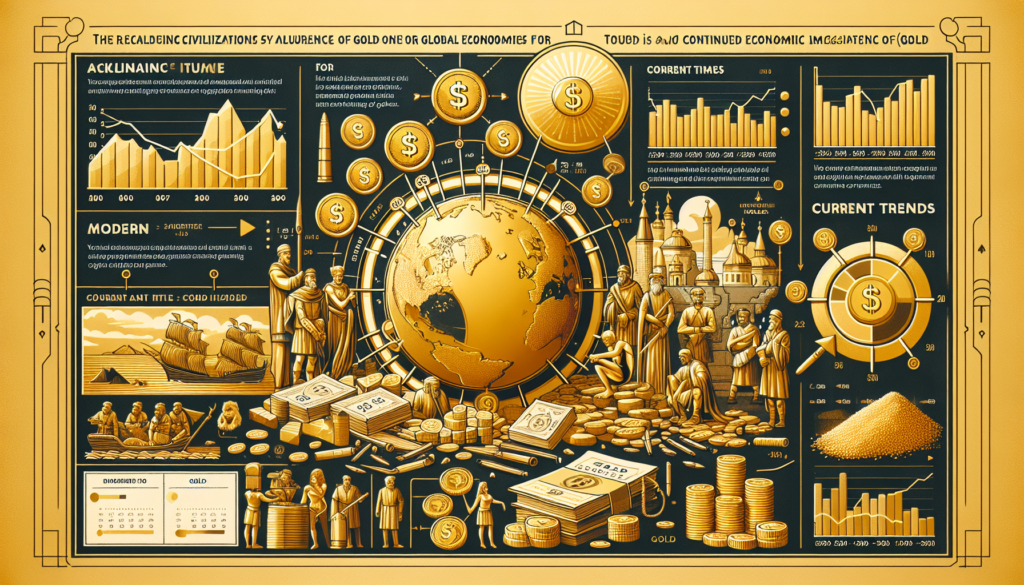Imagine a world where everything that glitters really is gold. It may sound like a fairy tale, but the impact of gold on world economies is far from imaginary. This precious metal has a profound influence on global markets, shaping the fortunes of nations and individuals alike. From its historical significance to its value as a safe haven investment, gold has become a prominent player in the financial landscape. In this article, we will explore the multifaceted impact of gold on world economies and unravel the secrets behind its shimmering allure.
Historical Significance of Gold
Gold as a Currency
Gold has been used as a form of currency for thousands of years, dating back to ancient civilizations such as the Egyptians and Greeks. Its rarity, malleability, and durability made it the ideal medium of exchange. Gold coins were introduced as a standardized form of currency, ensuring smooth transactions and trade. Throughout history, gold has represented wealth and power, playing a crucial role in the global economy.
Gold Standard
In the late 19th and early 20th centuries, the gold standard emerged as a monetary system where the value of a country’s currency was directly linked to a fixed quantity of gold. This system provided stability and confidence in the currency, as it could be exchanged for a fixed amount of gold. The gold standard influenced monetary policies and supported global economic growth during this era.
Gold Reserves
Central banks and governments around the world maintain gold reserves as a store of value and a safeguard against economic instability. These reserves provide confidence and aid in stabilizing their respective economies during times of crisis. Gold reserves serve as a benchmark of a country’s economic strength and play a crucial role in international trade and financial markets.
Gold Production and Consumption
Top Gold Producing Countries
Gold mining is a global industry, with several countries leading the way in terms of production. The top gold producing countries include China, Russia, Australia, the United States, and Canada. These countries possess vast reserves of gold, and their mining operations contribute significantly to the global supply of gold.
Gold Mining
Gold mining involves the extraction of gold from the earth’s crust. It can be obtained through various methods, such as placer mining, underground mining, and open-pit mining. The process of mining gold has evolved over the years, becoming more efficient and environmentally conscious. Mining companies play a vital role in job creation and economic development, particularly in regions where gold deposits are abundant.
Gold Consumption Trends
Gold consumption extends beyond its traditional use as a form of currency. Over the years, gold has remained highly valued for its aesthetic appeal, and its demand in the jewelry industry has remained strong. Beyond jewelry, gold is also used in various industries such as electronics, dentistry, and investing. The consumption of gold is influenced by factors such as economic trends, cultural customs, and personal preferences.

Gold as a Hedge Against Inflation
Gold as a Safe Haven
During times of economic uncertainty, gold has often been regarded as a safe haven asset. It serves as a hedge against inflation and protects against currency devaluation. Investors tend to flock to gold during periods of market volatility and geopolitical tensions, seeking its stability and preserving value.
Inverse Relationship with the Dollar
Gold and the US dollar have historically exhibited an inverse relationship. When the value of the dollar weakens, the price of gold tends to rise. This relationship is rooted in the perception that gold holds its value better during times of economic uncertainty, making it an attractive investment option compared to the fluctuating value of a currency.
Historical Performance during Inflationary Periods
Gold has proven to be an effective hedge against inflation throughout history. During periods of high inflation, the price of gold tends to rise as it retains its value relative to depreciating currencies. Investors often turn to gold as a means of preserving purchasing power and safeguarding wealth during inflationary periods.
Gold’s Impact on Exchange Rates
Gold Prices and Currency Values
The price of gold has a significant impact on exchange rates, as it influences the value of currencies relative to one another. A rise in gold prices can lead to an appreciation in currencies of gold-producing countries, while a decline in gold prices can result in the depreciation of these currencies. The interplay between gold prices and currency values underscores the interconnectedness of global financial markets.
Gold Imports and Exports
Gold plays a vital role in international trade, with countries importing and exporting gold to meet domestic demand and bolster their economies. Importing gold can serve as a means of increasing reserves and promoting economic stability, while exporting gold allows countries to generate revenue and stimulate economic growth. The balance of gold imports and exports contributes to fluctuations in exchange rates and trade imbalances.
Gold as a Tool for Currency Stability
Gold’s unique properties make it an effective tool for maintaining currency stability. Central banks can use gold to balance their foreign exchange reserves, providing stability and confidence in their currency. By backing a currency with gold, central banks can mitigate the risk of currency fluctuations and promote monetary stability within their respective economies.

Gold as an Investment Asset
Gold ETFs
Exchange-Traded Funds (ETFs) offer investors the opportunity to invest in gold without physically owning the metal. Gold ETFs track the price of gold and provide investors with an easily accessible and liquid investment option. These investment vehicles have gained popularity as a convenient way to invest in gold and diversify portfolios.
Demand for Gold Bars and Coins
Investors and collectors often acquire gold bars and coins as a tangible and portable form of investment. Gold bars and coins come in various sizes and purities, catering to different investment preferences. The demand for physical gold reflects investor sentiment and can influence the price of gold in financial markets.
Gold in Portfolio Diversification
Gold’s inclusion in investment portfolios can enhance diversification and reduce overall risk. As an alternative asset class, gold has demonstrated low correlation with other financial assets, providing a potential hedge against market volatility. By diversifying portfolios, investors can potentially mitigate losses and achieve a more balanced portfolio performance.
Gold’s Role in Central Banks
Central Bank Gold Reserves
Central banks hold significant amounts of gold as part of their foreign exchange reserves. These reserves act as a safety net, providing confidence and stability in times of economic uncertainty. Central bank gold reserves represent a country’s wealth and influence its monetary policies and international standing.
Gold Repatriation
In recent years, some central banks have repatriated their gold reserves, aiming to assert control over their holdings and enhance national sovereignty. Gold repatriation serves as a display of trust in domestic storage facilities and can impact international relations and financial markets.
Monetary Policy and Gold Holdings
Central banks’ gold holdings influence their monetary policy decisions. Gold reserves allow central banks to adjust their currency supply and maintain stability, providing leverage during economic crises. The management and utilization of gold holdings play a crucial role in a central bank’s ability to implement monetary policy effectively.
Gold’s Influence on Financial Markets
Gold Futures and Options Markets
Gold futures and options markets enable investors to speculate on the future price of gold without owning the physical metal. These derivative markets provide liquidity and price transparency, allowing for efficient price discovery. Gold futures and options play a significant role in financial markets, attracting both institutional and individual investors.
Gold Price Volatility
Gold prices can exhibit significant volatility, influenced by various factors such as economic data, geopolitical events, and investor sentiment. High price volatility in the gold market can impact financial markets, leading to increased uncertainty and potential shifts in investment strategies.
Effects on Risk Appetite
Gold’s performance often reflects investor risk appetite. During periods of economic stability and confidence, investors may reduce their exposure to gold, favoring riskier assets with potentially higher returns. Conversely, during times of economic uncertainty and market turmoil, investors tend to increase their allocation to gold, seeking its perceived safety and stability as a hedge against risk.
Gold Mining and Environmental Impact
Environmental Concerns
Gold mining operations can have significant environmental impacts. The extraction process involves clearing land, involving the use of chemicals, and disrupting ecosystems. Improper mining practices can lead to deforestation, soil erosion, and habitat destruction, threatening biodiversity and ecological balance.
Water Usage and Pollution
Gold mining requires large amounts of water for ore processing, resulting in water scarcity in mining regions. Moreover, the discharge of mining byproducts, such as cyanide and mercury, can lead to water pollution and contaminate aquatic ecosystems. Sustainable mining practices and water management strategies are essential for mitigating these environmental concerns.
Regulation and Sustainability
To address the environmental impact of gold mining, regulations and industry standards are in place to promote sustainable practices. Governments and mining companies are increasingly focused on implementing responsible mining measures, including reforestation efforts, water recycling, and minimizing the use of hazardous chemicals. Striking a balance between economic benefit and environmental stewardship is crucial for ensuring the long-term sustainability of the gold mining industry.
Gold’s Societal Impact
Gold Mining Communities
Gold mining can have significant social and economic implications for the communities where it takes place. It can contribute to job creation and economic development, supporting local businesses and infrastructure. However, mining operations can also lead to social challenges, such as displacement of communities, conflict over land rights, and cultural disruption. Engaging with local communities and implementing sustainable development initiatives are essential to mitigate these negative impacts.
Illegal Gold Mining
Illegal gold mining, often referred to as artisanal or small-scale mining, poses numerous challenges to both society and the environment. It is associated with environmental degradation, exploitation of labor, and funding of criminal activities. Efforts to combat illegal gold mining involve strengthening regulations, promoting responsible mining practices, and supporting alternative livelihoods for affected communities.
Social and Economic Implications
Gold’s societal impact extends beyond mining communities. The demand for gold jewelry, particularly in developing countries, provides employment opportunities for artisans and contributes to local economies. Gold’s role in cultural and traditional practices also holds significance, symbolizing wealth, status, and heritage. However, gold’s societal impact is not without its challenges, and the responsible and ethical sourcing of gold remains a critical consideration.
Gold’s Role in Jewelry and Luxury Goods
Gold Demand from the Jewelry Industry
The jewelry industry is a significant driver of gold demand worldwide. Gold’s luster, rarity, and association with luxury make it highly desirable for creating intricate and valuable pieces. The demand for gold jewelry is influenced by cultural traditions, fashion trends, and personal preferences, with different regions exhibiting varying patterns of demand.
Wedding and Cultural Significance
Gold holds deep cultural and symbolic meaning, particularly in relation to weddings. In many cultures, gold jewelry is an integral part of wedding ceremonies and represents love, commitment, and prosperity. The wedding industry’s demand for gold plays a significant role in driving gold consumption in various parts of the world.
Gold and Fashion Trends
Gold’s timeless appeal extends beyond traditional jewelry, as it finds its place in contemporary fashion trends. Designers and fashion houses incorporate gold into accessories, clothing, and even technology, creating a fusion of luxury and style. Gold’s versatility allows it to adapt to evolving fashion trends, ensuring its continued relevance in the dynamic world of luxury goods.
Gold’s historical significance, economic impact, and multi-faceted role in various industries highlight its enduring value. As a currency, investment asset, and symbol of luxury, gold continues to shape and influence the world economy. Understanding the intricacies of gold’s role allows individuals and nations to navigate the complex dynamics of global financial markets and appreciate the intricate relationship between gold and economic stability.

